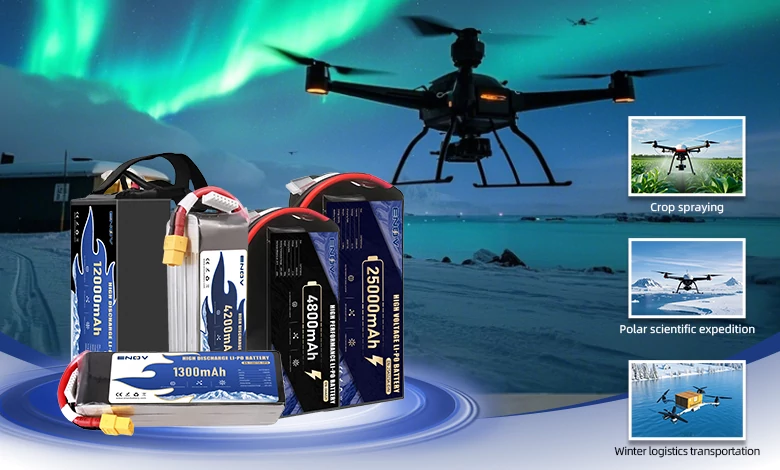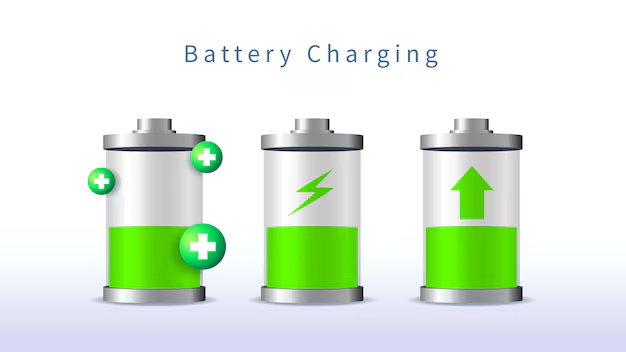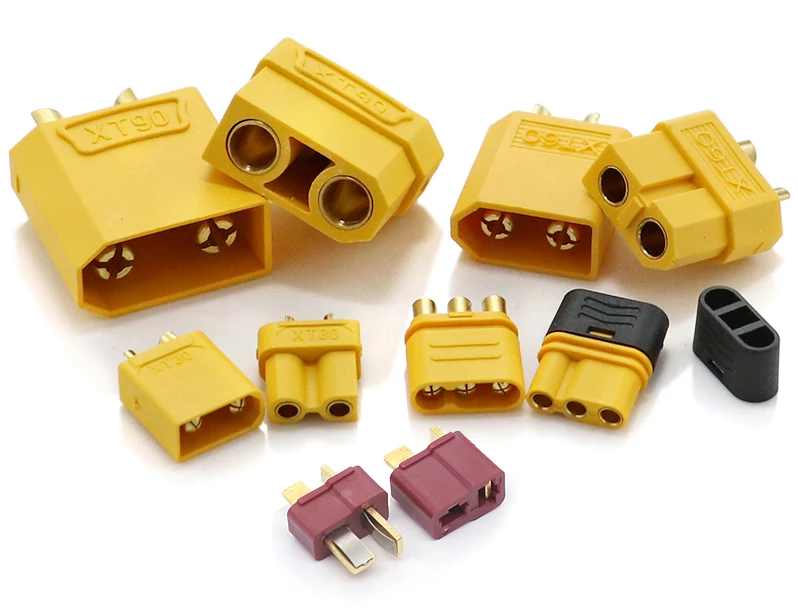Button-Type Lithium Batteries

ENOV High-Energy drone batteries power industrial and commercial drones. Delivering 220–320 Wh/kg energy density, they enable long flight times (30+ mins) and support fast charging (2C). Perfect for aerial photography, surveillance, and delivery drones.
Button-type lithium batteries are small-sized lithium batteries with a disc-like, button-like shape. They possess core advantages such as small volume, high energy density, and stable voltage, and are widely used in various microelectronic devices, serving as key power supply components to ensure the normal operation of these devices. The following is a comprehensive and detailed analysis from aspects including structural principle, model naming, performance characteristics, application scenarios, selection and safety, as well as storage and disposal.
1. Structural Composition and Working Principle
1.1 Structural Composition
The structural design of button-type lithium batteries revolves around the concepts of “miniaturization, sealing, and stability”, and the whole battery is divided into two parts: the outer shell and the internal core components.
• Outer Shell: Mostly made of stainless steel or nickel-plated steel, it consists of a positive electrode shell and a negative electrode cover. These two parts are tightly engaged through an insulating sealing ring to form a good sealing structure, which can not only prevent the leakage of internal electrolyte but also protect the internal components from interference from the external environment.
• Internal Core Components: Mainly include positive electrode, negative electrode, separator, and electrolyte. The positive electrode material usually adopts manganese dioxide, and the negative electrode material is metallic lithium. The separator functions to separate the positive and negative electrodes to avoid short circuits caused by direct contact between them. The electrolyte is responsible for conducting lithium ions and providing a medium for the smooth progress of electrochemical reactions.
1.2 Working Principle
Button-type lithium batteries realize the output of electrical energy through internal chemical changes. The specific process is as follows: during the discharge process, lithium atoms at the negative electrode lose electrons and are converted into lithium ions; the lithium ions move to the positive electrode with the help of the electrolyte, while the electrons flow to the positive electrode through the external circuit; the directional movement of electrons in the external circuit forms an electric current, thereby providing power support for the connected electronic devices.
2. Model Naming Rules and Common Specifications
2.1 Model Naming Rules
The model of a button-type lithium battery is composed of a combination of letters and numbers, with different parts representing specific meanings, facilitating users to quickly identify the key information of the battery.
• Letter Part: The first letter represents the chemical system of the battery. For example, “C” indicates a chemical battery system with lithium as the negative electrode and manganese dioxide as the positive electrode. The second letter represents the shape of the battery, and “R” means the battery is cylindrical, which is a common shape type of button-type lithium batteries.
• Number Part: Usually composed of four digits. The first two digits represent the diameter of the battery (unit: millimeters), and the last two digits represent the thickness of the battery (unit: millimeters; in some cases, the last two digits need to be divided by 10 to get the actual thickness. For example, the number “32” means the thickness is 3.2 millimeters).
2.2 Classification of Common Specifications
According to whether they are rechargeable or not, button-type lithium batteries are mainly divided into two categories: disposable and rechargeable. Each category includes a variety of common models, with specific specifications as follows:
Disposable Button-Type Lithium Batteries
• CR Series: This is the most commonly used series of disposable button-type lithium batteries, with a nominal voltage of 3V, belonging to the lithium-manganese system.
Common models include:
CR2032: Diameter 20mm, thickness 3.2mm, capacity 200-240mAh
CR2025: Diameter 20mm, thickness 2.5mm, capacity approximately 160mAh
CR2016: Diameter 20mm, thickness 1.6mm, capacity approximately 90mAh
CR2450: Diameter 24.5mm, thickness 5.0mm, capacity up to over 550mAh
• Series with a diameter of 16mm such as CR1632, CR1620, and CR1616, whose thickness and capacity decrease in sequence with the change of models.
• Other Series: In addition to the CR series, there are also 1.5V alkaline zinc-manganese button batteries (LR series, such as LR44), 1.55V silver oxide button batteries (SR series, such as SR44), and zinc-air batteries. Among them, silver oxide batteries have a high voltage platform and stable working voltage, making them suitable for precision instruments; alkaline zinc-manganese batteries are relatively low in price and suitable for low-power-consuming devices.
Rechargeable Button-Type Lithium Batteries
• LIR Series: Belonging to the lithium-ion system, with a nominal voltage of 3.6-3.85V. Common models include LIR1254, LIR1654, LIR1054, etc., with a capacity ranging from 40-80mAh. They mostly adopt a laminated or wound structure, have low internal resistance, support 2-5C fast charging, and are widely used in small rechargeable devices such as TWS earphones.
• ML/LV Series: The ML series refers to rechargeable lithium-manganese batteries (such as ML2032), and the LV series refers to rechargeable lithium-vanadium batteries (such as LV2032). Both have a nominal voltage of 3V, but their cycle life is limited, and they are mainly used in the industrial field.
3. Core Performance Characteristics
3.1 Advantages
• Advantages in Volume and Weight: Button-type lithium batteries usually have a thickness ranging from 1.0 to 7.7mm and a diameter from 4.8 to 30mm. With their small overall volume and light weight, they can be adapted to microelectronic devices with extremely limited space, providing strong support for the miniaturization and lightweight design of the devices.
• Excellent Voltage Stability: Taking the disposable CR series as an example, its voltage remains stable at around 3V for a long time, with small voltage fluctuations during the entire discharge process. It can provide stable power output for devices, ensuring the operation accuracy of the devices and reducing equipment failures caused by unstable voltage.
• Wide Operating Temperature Range: Different types of button-type lithium batteries have different adaptive temperature ranges. The operating temperature range of standard and high-current types is -30℃ to 70℃, that of quasi-heat-resistant types is -40℃ to 85℃, and that of heat-resistant types can reach -40℃ to 125℃. They can work normally in various complex scenarios such as low-temperature outdoor environments and high-temperature industrial environments.
• Good Leakage Resistance and Preservability: By adopting newly developed battery structures and electrolytes, combined with a sealed shell design, button-type lithium batteries have excellent long-term leakage resistance. At the same time, their active materials and electrolytes have high stability, and with unique packaging technology, the self-discharge rate is extremely low. In a normal temperature and humidity environment, the annual self-discharge rate is less than 1%, and the storage life can reach 5-10 years. Some models can still maintain a certain amount of electricity after being stored for more than 10 years.
• Good Environmental Performance: Most button-type lithium batteries produced in modern times adopt a mercury-free design, which complies with environmental protection standards and reduces the risk of environmental pollution.
3.2 Disadvantages
• Low Capacity: Restricted by volume, the energy storage capacity of button-type lithium batteries is much lower than that of cylindrical, prismatic, and pouch batteries. Most models have a capacity ranging from 90 to 550mAh, which cannot meet the power demand of devices with high power and long battery life, and are only suitable for low-power-consuming devices.
• Many Charging Restrictions: Most button-type lithium batteries are disposable and need to be replaced after use. In the long run, the replacement cost may be higher than that of rechargeable batteries; while rechargeable button-type lithium batteries (such as the LIR series) are relatively high in price, and their cycle life is also shorter than that of ordinary cylindrical lithium batteries, so their application range is limited to a certain extent.
4. Application Fields
Relying on the unique advantages of “small volume + low-power adaptation”, button-type lithium batteries are widely used in multiple fields, with specific scenarios as follows:
• Consumer Electronics Field: They are the core power sources for common consumer electronic products such as electronic watches, calculators, car remote keys, electronic scales, LED lights, small toys, smart bracelets, and TWS Bluetooth earphones. Meanwhile, the CMOS batteries on computer motherboards also generally use button-type lithium batteries, which are used to store the motherboard BIOS settings after a power outage to ensure that various parameters are normal when the computer is restarted.
• Medical Equipment Field: Suitable for portable medical equipment such as digital thermometers, blood glucose meters, and hearing aids. These devices have extremely high requirements for the miniaturization and stability of power supplies, and button-type lithium batteries can accurately meet their power supply needs, ensuring the normal operation of the devices and providing support for medical testing and auxiliary treatment.
• Industrial and IoT Fields: Play an important role in devices such as small industrial sensors (such as IoTS sensors, wireless trackers) and active RFID tags. They can provide long-term and stable power supply in complex industrial environments, ensuring the continuity of sensor data collection and transmission, and contributing to the development of industrial intelligence.
• Other Special Fields: Micro-components in some military and aerospace equipment, as well as low-power accessories such as electronic gifts and smart cards, also select dedicated button-type lithium batteries according to requirements.
5. Selection and Safe Use
5.1 Key Selection Points
• Matching Core Parameters: First, clarify the voltage specification required by the device. For example, 3V devices are compatible with the CR series, and 3.6V devices are compatible with the LIR series. Then, accurately check the size (diameter and thickness) of the battery to ensure it perfectly matches the device’s battery compartment, avoiding installation difficulties or poor contact caused by mismatched sizes. At the same time, select a battery with an appropriate capacity according to the power consumption of the device. For high-power-consuming devices (such as LED lights), priority should be given to models with higher capacity to extend the service time.
• Distinguishing Charging Types: Clearly understand the type of battery supported by the device. Do not mix disposable batteries with rechargeable batteries, otherwise, it may cause device damage, battery leakage, or shorten the battery life. For rechargeable devices, the corresponding rechargeable button-type lithium batteries (such as the LIR series) should be selected, and a dedicated charger should be used for charging to avoid safety problems caused by the use of non-specialized chargers.
• Choosing Reliable Brands: Priority should be given to products from high-quality brands. The button-type lithium batteries of these brands are more guaranteed in terms of capacity accuracy, leakage resistance, and service life. Avoid purchasing cheap counterfeit products, as counterfeit batteries often have problems such as false capacity labeling, poor safety, and short service life, which may cause damage to the device.
5.2 Precautions for Safe Use
• Preventing the Risk of Accidental Swallowing: Button-type lithium batteries are small in size and similar in shape to candies, so the risk of accidental swallowing by children and pets is extremely high. After being swallowed, the battery may get stuck in the esophagus, causing severe internal burns in as fast as 2 hours, and even endangering life. Therefore, in daily life, batteries should be stored in a safe place out of the reach of children and pets. Packaging with child safety protection functions should be used, and batteries should not be placed loosely in easily accessible places such as desktops and sofas.
• Avoiding Improper Operations: It is strictly forbidden to short-circuit the battery. For example, do not let the battery come into contact with metal objects such as keys, coins, and scissors to prevent the formation of a circuit that generates heat, which may cause the battery to rupture, catch fire, or leak. Heating, squeezing, or disassembling the battery is prohibited. These operations will damage the battery structure, lead to the leakage of internal substances of the battery, and pose safety hazards. When installing the battery, carefully identify the positive and negative directions (the positive electrode is usually marked with a “+” sign or has a flat top design, and the negative electrode is marked with a “-” sign or has a raised edge), and install it correctly according to the device instructions. Incorrect direction may damage the device or cause battery leakage.
• Standardizing the Replacement Process: When replacing the battery, it is recommended to use plastic tools for operation and avoid using metal tools to prevent the metal tools from contacting the battery terminals and causing a short circuit. Do not mix old and new batteries. Mixing them will cause unbalanced voltage of the battery pack, accelerate the aging of old batteries, and also affect the performance of new batteries. If the battery is found to have abnormal conditions such as swelling, leakage, or shell damage, stop using it immediately and dispose of it in the correct way. Do not continue to install and use it.
6. Storage and Disposal
6.1 Storage Methods
• Controlling the Storage Environment: Button-type lithium batteries should be stored in an environment with room temperature (15-25℃), dryness, and good ventilation. Avoid placing them in high-temperature, humid places, or under direct sunlight. High temperature will accelerate the self-discharge rate of the battery and shorten the battery life; a humid environment may cause rust on the battery shell and affect the battery performance; extremely low temperature may also affect the fluidity of the electrolyte and reduce the use effect of the battery.
• Proper Packaging and Isolation: Unused batteries should be kept in their original packaging or stored in a sealed non-conductive container (such as a plastic box) to prevent short circuits caused by collision or contact between batteries. At the same time, different types, different batches, and old and new batteries should be stored separately to avoid confusion and facilitate quick identification and retrieval during subsequent use. For used old batteries, they should be stored separately and marked to avoid mixing with new batteries.
6.2 Environmentally Friendly Disposal Methods
• Prohibiting Random Discarding: Button-type lithium batteries belong to hazardous waste, which contain heavy metals and chemical substances. If they are discarded together with ordinary domestic waste, these harmful substances may seep into the soil and groundwater, causing pollution to the environment and endangering the ecosystem and human health. Therefore, it is strictly forbidden to randomly throw waste button-type lithium batteries into the trash can.
• Choosing Standard Recycling Channels: Waste batteries should be sent to local battery recycling centers, electronic product stores, or special battery recycling bins set up in large supermarkets. Some communities also organize regular waste battery recycling activities. You can pay attention to community notices and participate in recycling in a timely manner. Before sending the waste batteries to the recycling point, you can seal the positive and negative ends of the batteries with tape to prevent short circuits caused by contact between batteries during transportation.
• Following Local Regulatory Requirements: Different regions may have different regulations and policies regarding the disposal of waste batteries. When disposing of waste button-type lithium batteries, it is necessary to understand the relevant local regulations in advance, operate in strict accordance with the regulatory requirements, actively fulfill environmental protection responsibilities, and jointly protect the ecological environment.
Quick inquiry
Drop us a line, and we’ll get back to you within 24 hours.

Ariana Yuan
Digital Operations Manager
Website Planning|Marketing Project Management for Drone Batteries|Scheduled Content Refresh|SEO Optimization

Ariana Yuan
Digital Operations Manager
Website Planning|Marketing Project Management for Drone Batteries|Scheduled Content Refresh|SEO Optimization




